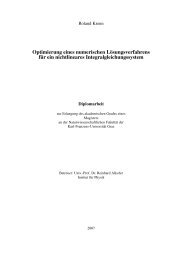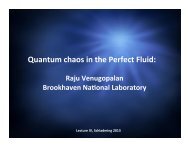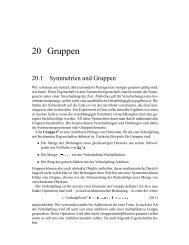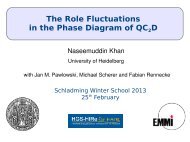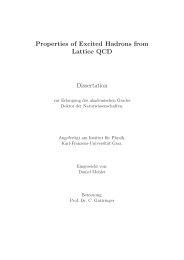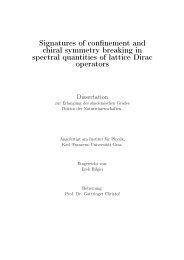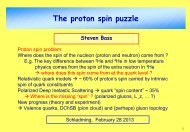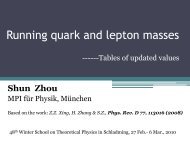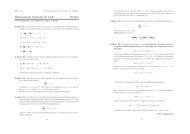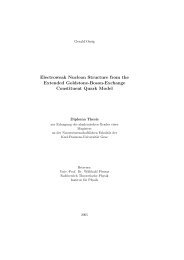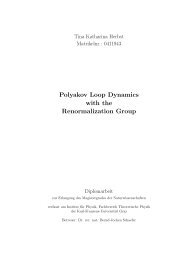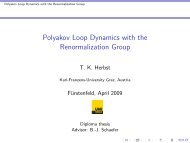The QCD Quark Propagator in Coulomb Gauge and - Institut für Physik
The QCD Quark Propagator in Coulomb Gauge and - Institut für Physik
The QCD Quark Propagator in Coulomb Gauge and - Institut für Physik
You also want an ePaper? Increase the reach of your titles
YUMPU automatically turns print PDFs into web optimized ePapers that Google loves.
Chapter 6. Nucleon Form Factors <strong>in</strong> a Covariant Diquark-<strong>Quark</strong> model 73<br />
where γ, α are, respectively, the vector <strong>in</strong>dices of the photon <strong>and</strong> axial-vector diquark.<br />
For simplicity we proceed under the assumption that<br />
T (l 1 , l 2 ) = κ T , (6.82)<br />
i.e. a constant, for which a typical value is [OAS00]:<br />
κ T ∼ 2 . (6.83)<br />
In the nucleons’ rest frame, a outst<strong>and</strong><strong>in</strong>g piece of the Faddeev amplitude that describes<br />
an axial-vector diquark <strong>in</strong>side the bound state can be characterised as conta<strong>in</strong><strong>in</strong>g<br />
a byst<strong>and</strong>er quark whose sp<strong>in</strong> is antiparallel to that of the nucleon, with the axial-vector<br />
diquark’s parallel. <strong>The</strong> <strong>in</strong>teraction pictured <strong>in</strong> this diagram does not affect the byst<strong>and</strong>er<br />
quark but the transformation of an axial-vector diquark <strong>in</strong>to a scalar effects a flip of the<br />
quark sp<strong>in</strong> with<strong>in</strong> the correlation. After this transformation, the sp<strong>in</strong> of the nucleon must<br />
be formed by summ<strong>in</strong>g the sp<strong>in</strong> of the byst<strong>and</strong>er quark, which is still aligned antiparallel<br />
to that of the nucleon, <strong>and</strong> the orbital angular momentum between that quark <strong>and</strong> the<br />
scalar diquark. 8 This argument, while not sophisticated, does motivate an expectation<br />
that diagram 4 will strongly impact on the nucleons’ magnetic form factors.<br />
6.4.5 Seagull contributions<br />
<strong>The</strong> two-loop diagrams 5 <strong>and</strong> 6 are the so-called “seagull” terms, which appear as partners<br />
to diagram 3 <strong>and</strong> arise because b<strong>in</strong>d<strong>in</strong>g <strong>in</strong> the nucleons’ Faddeev equations is effected by<br />
the exchange of nonpo<strong>in</strong>tlike diquark correlations [OPS00].<br />
<strong>The</strong> explicit expression for their contribution to the nucleons’ form factors is given by<br />
J sg<br />
µ = 1 2 S(k q)∆ i (k d ) ( X i µ (p q, q ′ , k d )S T (q ′ )¯Γ jT (p ′ 2 , p d)<br />
− Γ i (p 1 , k d )S T (q) ¯X j µ (−k q, −q, p d ) ) ∆ j (p d )S(p q ) , (6.84)<br />
where, aga<strong>in</strong>, the superscripts are summed. In equations(6.79) <strong>and</strong> (6.84) the momenta<br />
are<br />
q = ˆηP − ηP ′ − p − k , q ′ = ˆηP ′ − ηP − p − k ,<br />
p 1 = (p q − q)/2 , p ′ 2 = (−k q + q ′ )/2 ,<br />
p ′ 1 = (p q − q ′ )/2 , p 2 = (−k q + q)/2 .<br />
(6.85)<br />
8 A less prom<strong>in</strong>ent component of the amplitude has the byst<strong>and</strong>er quark’s sp<strong>in</strong> parallel to that of the<br />
nucleon while the axial-vector diquark’s is antiparallel: this q ↑ ⊕ (qq) ↓ 1 + system has one unit of angular<br />
momentum. That momentum is absent <strong>in</strong> the q ↑ ⊕(qq) 0 + system. Other comb<strong>in</strong>ations also contribute via<br />
diagram 3 but all mediated processes <strong>in</strong>evitably require a modification of sp<strong>in</strong> <strong>and</strong>/or angular momentum.



